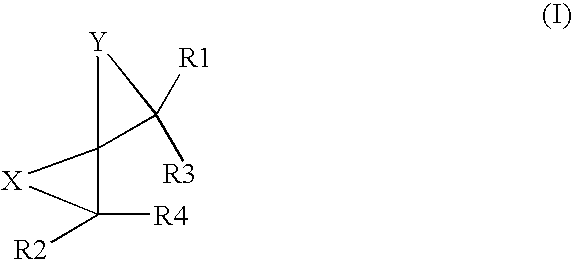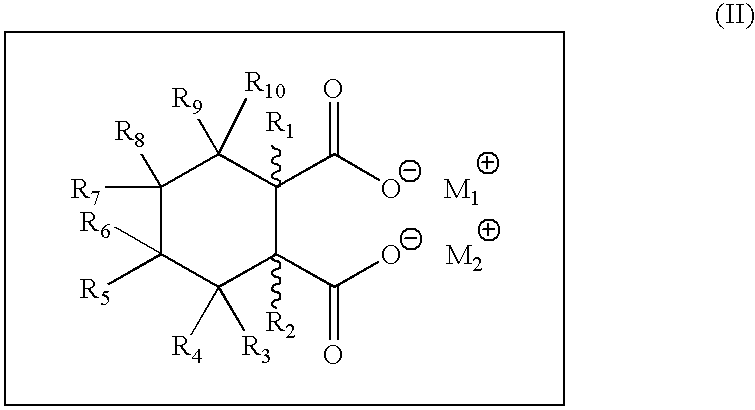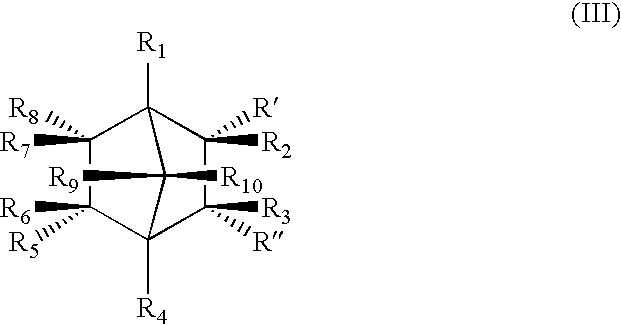Low density polyethylene articles exhibiting significantly decreased warpage at reduced cooling times
a technology of low density polyethylene and cooling time, applied in the direction of plastic/resin/waxes insulators, organic insulators, electrical appliances, etc., can solve the problems of extreme warpage characteristics within the target finished article, aesthetically and physically disconcerting, and creating undesirable costs
- Summary
- Abstract
- Description
- Claims
- Application Information
AI Technical Summary
Benefits of technology
Problems solved by technology
Method used
Image
Examples
example 1
Disodium Bicyclo[2.2.1]heptane-2,3-dicarboxylate
To a solution of disodium bicyclo[2.2.1]hept-5-ene-2,3-dicarboxylate (10.0 g, from example 3) in water (100 g) was added 0.5 g palladium on activated carbon (5 wt %). The mixture was transferred into a Parr reactor and was subjected to hydrogenation (50 psi, room temperature) for 8 hours. The activated carbon was filtered out, and the water was removed in vacuo at 75° C. The resulting product was dried and milled (m.p>300° C.). NMR and IR analyses were consistent with that of the expected structure. This product is commercially available from Milliken Chemical under the trade name Hyperfomm HPN-68.
example 2
Calcium Bicyclo[2.2.1]heptane-2,3-dicarboxylate
To a solution of disodium bicyclo[2.2.1]heptane-2,3-dicarboxylate (22.6 g, 0.1 mols) in water (150 g) was added a solution of calcium chloride dihydrate (14.7 g, 0.1 mols) in water (100 g). The mixture was stirred at 60° C. for 2 hours. The resulting white precipitate was filtered. The white powdery product was dried and milled (m.p. >300° C.).
example 3
Disodium bicyclo[2.2.1]hept-5-ene-2,3-dicarboxylate
To a suspension of endo-bicyclo[2.2.1]hept-5-ene-2,3-dicarboxylic anhydride (16.4 g, 0.1 mols) in water (100 g) was added sodium hydroxide (8.0 g, 0.2 mols) at room temperature. The mixture was then stirred at 80° C. for 2 hours. A clear, homogeneous solution was obtained. Water was removed in vacuum at 75° C. and the resulting white crystalline product was dried and milled (m.p. >300° C.).
Other Group I and II salts, lithium, potassium, rubidium, magnesium, strontium, and barium salts of bicyclo[2.2.1]heptane dicarboxylate and bicyclo[2.2.1]hept-5-ene-2,3 dicarboxylate salts were synthesized through similar procedures.
PUM
| Property | Measurement | Unit |
|---|---|---|
| temperature | aaaaa | aaaaa |
| density | aaaaa | aaaaa |
| crystallization temperatures | aaaaa | aaaaa |
Abstract
Description
Claims
Application Information
 Login to View More
Login to View More - R&D
- Intellectual Property
- Life Sciences
- Materials
- Tech Scout
- Unparalleled Data Quality
- Higher Quality Content
- 60% Fewer Hallucinations
Browse by: Latest US Patents, China's latest patents, Technical Efficacy Thesaurus, Application Domain, Technology Topic, Popular Technical Reports.
© 2025 PatSnap. All rights reserved.Legal|Privacy policy|Modern Slavery Act Transparency Statement|Sitemap|About US| Contact US: help@patsnap.com



